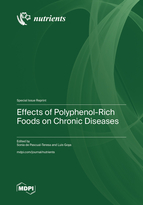Effects of Polyphenol-Rich Foods on Chronic Diseases
A special issue of Nutrients (ISSN 2072-6643). This special issue belongs to the section "Phytochemicals and Human Health".
Deadline for manuscript submissions: closed (30 July 2023) | Viewed by 40821
Special Issue Editors
Interests: polyphenols; anthocyanins; flavanols; health; nutrition; aging; cardiovascular; visual; neurological
Interests: bioactive compounds; biochemical and molecular mechanisms; antioxidant activity; cell culture; polyphenols
Special Issues, Collections and Topics in MDPI journals
Special Issue Information
Dear Colleagues,
Polyphenols comprise an extended number of compounds belonging to groups as different as flavonoids and hydroxycinnamic acids found mainly in plant foods and derived products, but having also been found in trace amounts in animal products after they had consumed such polyphenol-rich plant products.
Polyphenols have been gaining attention since the 1990s, and although not being considered nutrients, their study in relation to their health implications has produced thousands of scientific publications. However, it is still difficult to define their implications concerning health maintenance and chronic disease prevention or even treatment. There are many difficulties in their study, the first being the fact that this group of compounds includes such a diverse array of chemical structures and their effects as part of food products in which they coexist with many other nutrients and non-nutrients. However, today it is generally accepted that they exert a vasoprotective effect, might modulate blood pressure, exert a regulatory effect both in the lipid and glucidic metabolism and have an immunomodulatory and gut microbial effect. It is by all these means that polyphenols might be of use in the prevention and treatment of chronic diseases as prevalent as obesity, cardiovascular disease or neurocognitive decline.
Dr. Sonia de Pascual-Teresa
Dr. Luis Goya
Guest Editors
Manuscript Submission Information
Manuscripts should be submitted online at www.mdpi.com by registering and logging in to this website. Once you are registered, click here to go to the submission form. Manuscripts can be submitted until the deadline. All submissions that pass pre-check are peer-reviewed. Accepted papers will be published continuously in the journal (as soon as accepted) and will be listed together on the special issue website. Research articles, review articles as well as short communications are invited. For planned papers, a title and short abstract (about 100 words) can be sent to the Editorial Office for announcement on this website.
Submitted manuscripts should not have been published previously, nor be under consideration for publication elsewhere (except conference proceedings papers). All manuscripts are thoroughly refereed through a single-blind peer-review process. A guide for authors and other relevant information for submission of manuscripts is available on the Instructions for Authors page. Nutrients is an international peer-reviewed open access semimonthly journal published by MDPI.
Please visit the Instructions for Authors page before submitting a manuscript. The Article Processing Charge (APC) for publication in this open access journal is 2900 CHF (Swiss Francs). Submitted papers should be well formatted and use good English. Authors may use MDPI's English editing service prior to publication or during author revisions.
Keywords
- polyphenol
- chronic disease
- obesity
- cardiovascular
- neurological








